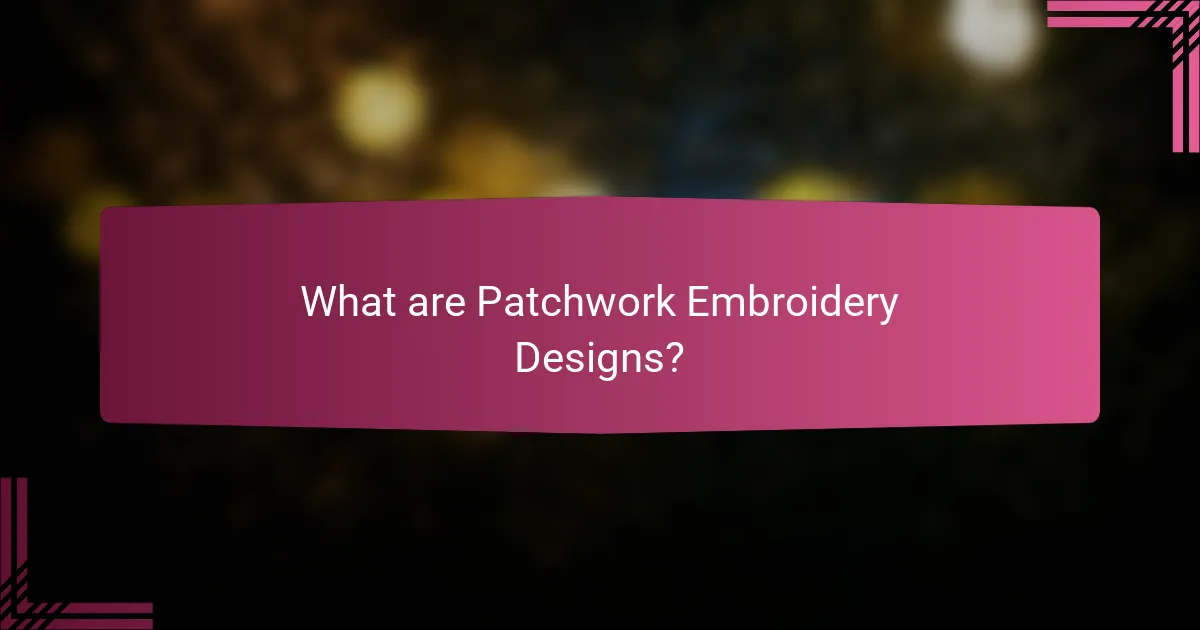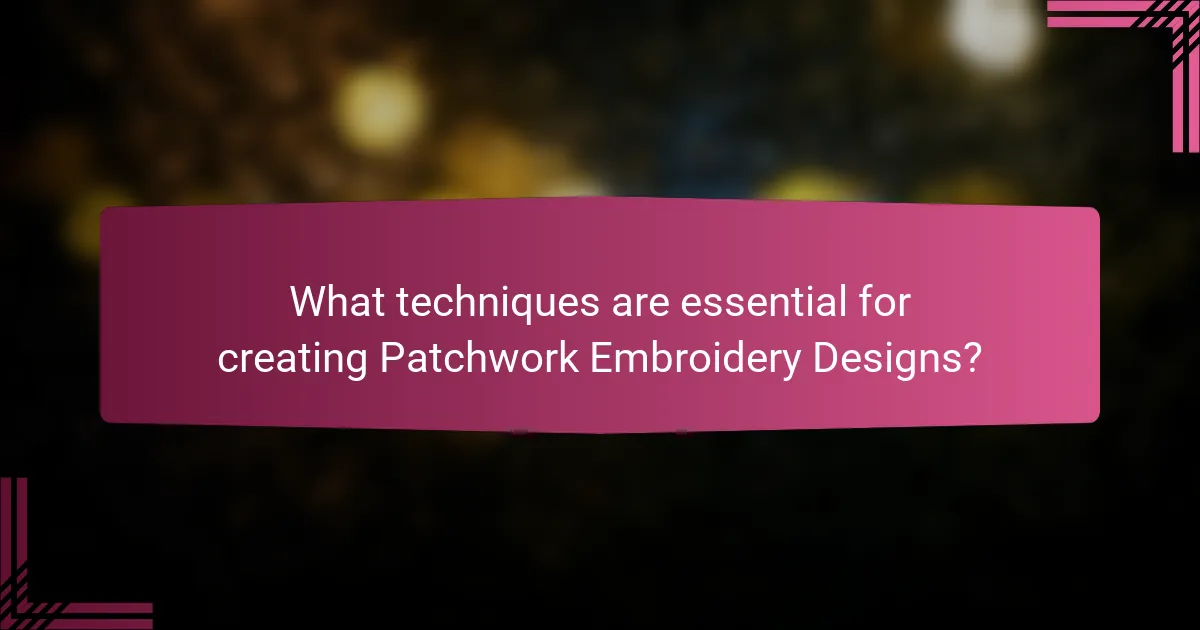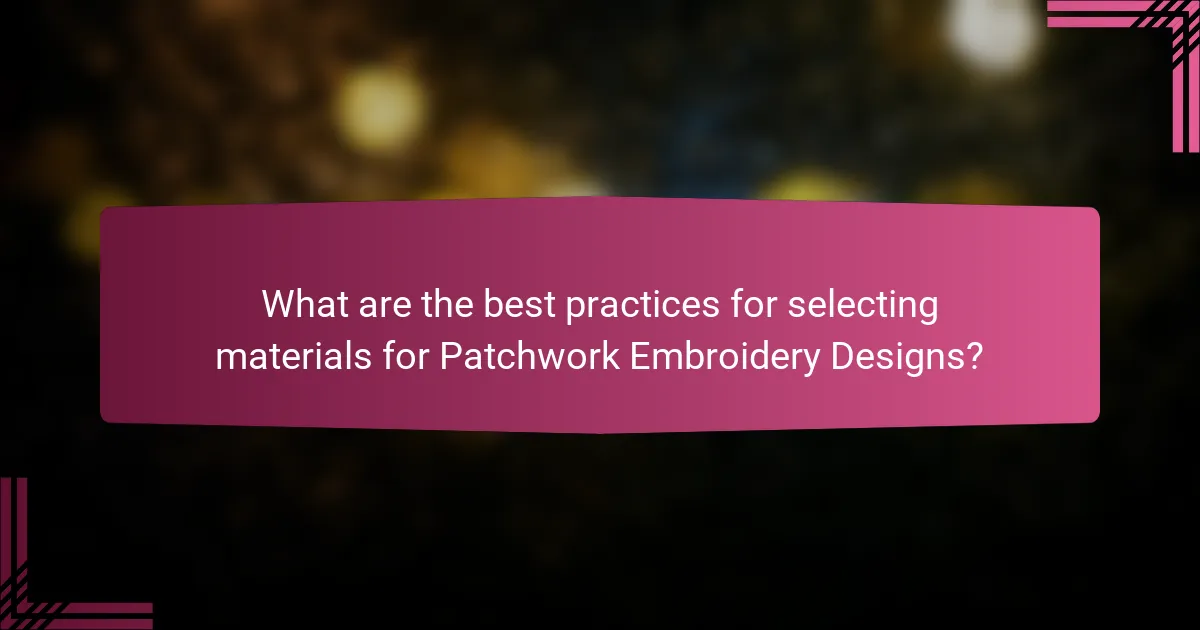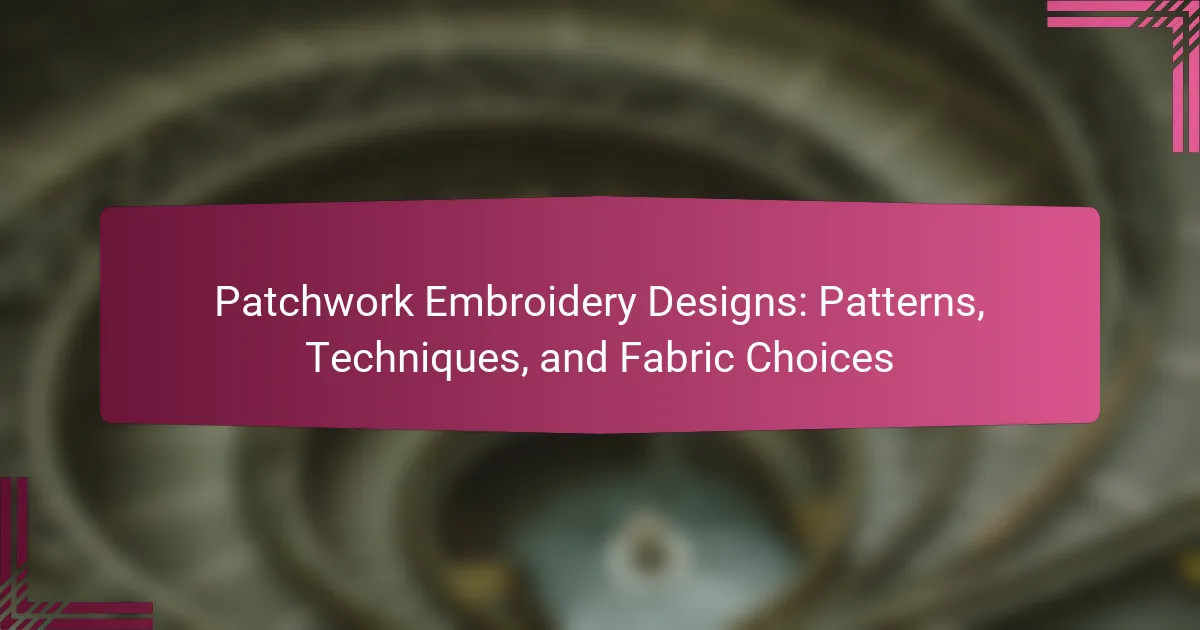
What are Patchwork Embroidery Designs?
Patchwork embroidery designs are decorative patterns created by stitching together pieces of fabric. These designs often combine various colors, textures, and prints to form a cohesive artwork. They are commonly used in quilts, clothing, and home decor. The technique dates back centuries and showcases cultural heritage through fabric selection. Patchwork embroidery can include intricate motifs and embellishments, enhancing visual appeal. This art form allows for creativity and personalization in textile projects. Historical examples can be found in traditional quilts from various cultures, highlighting its enduring popularity.
How do Patchwork Embroidery Designs differ from traditional embroidery?
Patchwork embroidery designs differ from traditional embroidery in that they combine multiple fabric pieces into a cohesive design. Traditional embroidery typically involves stitching patterns directly onto a single piece of fabric. In patchwork, various fabrics are sewn together before the embroidery is applied. This method allows for greater creativity and texture. Patchwork designs often showcase diverse colors and patterns from the different fabric pieces. Traditional embroidery, on the other hand, focuses on embellishing a uniform fabric surface. The layering in patchwork can create a three-dimensional effect that is not present in traditional embroidery. Additionally, patchwork often incorporates techniques such as quilting, which adds another layer of complexity.
What techniques are unique to Patchwork Embroidery Designs?
Unique techniques in patchwork embroidery designs include appliqué, reverse appliqué, and crazy quilting. Appliqué involves sewing a piece of fabric onto a larger piece to create a design. Reverse appliqué is where the top layer is cut away to reveal a contrasting fabric underneath. Crazy quilting combines various fabric pieces in an irregular pattern, often embellished with embroidery stitches. Each technique adds texture and visual interest to the final piece. These methods have historical roots, with appliqué dating back to ancient cultures, showcasing their enduring appeal in textile arts.
How do cultural influences shape Patchwork Embroidery Designs?
Cultural influences shape patchwork embroidery designs by reflecting the traditions and values of specific communities. Each culture contributes unique patterns, colors, and techniques influenced by historical context. For instance, African patchwork often features vibrant colors and geometric patterns, symbolizing tribal identity. In contrast, Asian designs may incorporate motifs representing nature and [censured]. Historical trade routes have also facilitated the exchange of textile techniques and styles, enriching patchwork designs across cultures. Additionally, social events and rituals often inspire specific designs, making them significant in cultural storytelling. This interplay of cultural elements creates a diverse tapestry of patchwork embroidery that highlights the heritage and artistic expression of different societies.
What are the common patterns found in Patchwork Embroidery Designs?
Common patterns found in patchwork embroidery designs include geometric shapes, floral motifs, and abstract designs. Geometric shapes often consist of squares, triangles, and hexagons. Floral motifs incorporate various flower designs, enhancing visual appeal. Abstract designs allow for creative expression through unique shapes and color combinations. These patterns are often stitched using diverse embroidery techniques, such as satin stitch and chain stitch. Historical context shows that patchwork has roots in various cultures, influencing patterns used today. For example, the Amish community is known for its distinct geometric patterns. Overall, these common patterns contribute to the rich tradition of patchwork embroidery.
Which geometric patterns are popular in Patchwork Embroidery?
Popular geometric patterns in patchwork embroidery include triangles, squares, and diamonds. These shapes create visually appealing designs. Triangles often form intricate patterns like pinwheels. Squares are used in classic quilt blocks, providing a structured look. Diamonds add a dynamic element through their angular form. Other patterns include hexagons, which allow for tessellation effects. These geometric designs are favored for their versatility and aesthetic appeal. The use of these shapes dates back centuries, showcasing their enduring popularity in textile arts.
How do floral motifs enhance Patchwork Embroidery Designs?
Floral motifs enhance patchwork embroidery designs by adding visual interest and depth. They introduce vibrant colors and intricate patterns that draw attention. Floral designs can evoke emotions and connect with nature, making the overall piece more appealing. Additionally, these motifs can symbolize various themes, such as growth and beauty. The use of floral elements can also create a cohesive look when combined with different fabrics. Historical examples show that floral motifs have been used in textiles for centuries, demonstrating their lasting popularity. This versatility allows for personalization in patchwork embroidery, catering to individual tastes. Overall, floral motifs significantly enrich the aesthetic value of patchwork embroidery designs.
What role do fabric choices play in Patchwork Embroidery Designs?
Fabric choices significantly influence patchwork embroidery designs. Different fabrics offer unique textures, colors, and weights. These characteristics affect the overall aesthetic of the design. For example, cotton provides durability and ease of stitching. Silk, on the other hand, adds a luxurious sheen but can be more challenging to work with.
The choice of fabric also impacts the embroidery technique used. Heavier fabrics may require different needles and thread types compared to lighter ones. Additionally, contrasting fabrics can enhance visual interest and depth in the design.
Research from the “Journal of Textile Science” indicates that fabric selection directly correlates with the final appearance and functionality of embroidered pieces. Thus, careful consideration of fabric is essential for achieving desired outcomes in patchwork embroidery.
What types of fabrics are commonly used for Patchwork Embroidery?
Cotton fabrics are commonly used for patchwork embroidery. They are favored for their durability and ease of handling. Cotton is available in various prints and colors, making it versatile for different designs. Linen is another option, known for its strength and texture. It adds a unique character to patchwork pieces. Polyester blends are also used for their wrinkle resistance and affordability. These fabrics can mimic the look of natural fibers while offering practical benefits. Additionally, silk can be incorporated for a luxurious touch, though it is less common due to its delicate nature. Each fabric type contributes specific qualities to the overall patchwork design.
How does fabric texture influence the final design?
Fabric texture significantly influences the final design of patchwork embroidery. Texture affects the visual appeal and tactile experience of the design. Different textures can create depth and dimension in the artwork. For example, a rough texture can add a rustic feel, while a smooth texture may convey elegance. The choice of texture also impacts the way light interacts with the fabric. This interaction can enhance or diminish color vibrancy in the design. Additionally, texture influences the stitching techniques used in embroidery. Certain textures may require specific stitching methods to achieve the desired effect. Overall, fabric texture is a crucial element in determining the aesthetic and functional qualities of the final design.

What techniques are essential for creating Patchwork Embroidery Designs?
Essential techniques for creating patchwork embroidery designs include piecing, appliqué, and quilting. Piecing involves sewing together various fabric pieces to form a cohesive design. This technique allows for creating intricate patterns and shapes. Appliqué adds decorative elements by stitching smaller pieces of fabric onto a larger base. It enhances visual interest and texture in the design. Quilting then secures the layers of fabric together, often adding additional decorative stitching. These three techniques are foundational in patchwork embroidery, enabling a wide range of creative expressions.
How can beginners get started with Patchwork Embroidery techniques?
Beginners can get started with patchwork embroidery techniques by first gathering essential materials. This includes fabric scraps, embroidery thread, needles, and scissors. Learning basic stitches is crucial. Common stitches like running stitch, backstitch, and blanket stitch are foundational.
Next, beginners should practice creating simple patterns. They can start with small projects like coasters or simple patches. Following tutorials online can provide guidance. Many resources offer step-by-step instructions for beginners.
Joining a local or online crafting community can also be beneficial. Engaging with others can provide support and inspiration. Overall, consistent practice will enhance skills over time.
What basic stitches should beginners learn for Patchwork Embroidery?
Beginners in patchwork embroidery should learn basic stitches such as the running stitch, backstitch, and whip stitch. The running stitch is a simple stitch that creates a line of evenly spaced stitches. It is often used for outlining and filling in shapes. The backstitch provides a strong, continuous line and is useful for outlining designs. The whip stitch is typically used to join two pieces of fabric together, making it essential for patchwork construction. Mastering these stitches lays a solid foundation for more complex embroidery techniques.
How can one effectively combine different techniques in Patchwork Embroidery?
To effectively combine different techniques in Patchwork Embroidery, one should start by selecting complementary styles. Techniques like appliqué, quilting, and embroidery can enhance each other. For example, using appliqué to create shapes can add dimension to a quilted background.
Next, consider the color palette. Harmonious colors can unify various techniques. Mixing textures, such as combining smooth and rough fabrics, adds visual interest.
Planning the layout is crucial. Sketching a design helps visualize how different techniques will interact.
Lastly, practice is essential. Experimenting with small samples allows for refinement before applying techniques to larger projects. This methodical approach ensures a cohesive and aesthetically pleasing result.
What advanced techniques can enhance Patchwork Embroidery Designs?
Advanced techniques that can enhance patchwork embroidery designs include free-motion embroidery, appliqué, and layering. Free-motion embroidery allows for intricate designs by moving the fabric freely under the needle. This technique creates unique patterns and textures. Appliqué involves sewing fabric shapes onto a base fabric, adding depth and visual interest. Layering combines various fabrics and stitches to create a three-dimensional effect. Techniques such as thread painting and embellishing with beads can further enhance the design. Each method contributes to a richer aesthetic and greater complexity in the finished piece.
How does layering affect the depth of Patchwork Embroidery?
Layering enhances the depth of patchwork embroidery by creating a three-dimensional effect. This technique involves stacking multiple fabric layers, which adds visual interest and texture. The contrast between different fabrics can highlight intricate designs. Additionally, layering allows for the incorporation of various colors and patterns. This variation can make the embroidery appear more dynamic and engaging. The depth achieved through layering can also emphasize the craftsmanship involved in the piece. Ultimately, layering is a fundamental technique that significantly impacts the overall aesthetic of patchwork embroidery.
What are the benefits of using appliqué in Patchwork Embroidery?
Appliqué enhances patchwork embroidery by adding texture and dimension. It allows for intricate designs that are visually appealing. Appliqué can incorporate various fabrics, creating contrast and interest. This technique is versatile, enabling the use of different shapes and motifs. It also provides an opportunity for personalization in projects. Appliqué can be quicker than traditional embroidery methods. The process can be done by hand or machine, offering flexibility. Overall, appliqué enriches the aesthetic quality of patchwork embroidery.

What are the best practices for selecting materials for Patchwork Embroidery Designs?
The best practices for selecting materials for patchwork embroidery designs include choosing high-quality fabrics, ensuring color compatibility, and considering the weight and texture of the materials. High-quality fabrics, such as cotton or linen, provide durability and ease of stitching. Color compatibility is crucial for achieving a cohesive design; using a color wheel can help identify complementary shades. The weight of the fabric affects the overall drape and appearance of the finished piece. Additionally, texture can add depth to the design; mixing smooth and textured fabrics can create visual interest. It is also essential to pre-wash fabrics to prevent shrinkage and color bleeding. Finally, selecting materials that are easy to work with will enhance the overall stitching experience.
How do color choices impact the overall look of Patchwork Embroidery Designs?
Color choices significantly impact the overall look of patchwork embroidery designs. They determine the visual harmony and contrast within the design. A cohesive color palette can create a unified appearance. Conversely, contrasting colors can add vibrancy and interest. The choice of colors influences the emotional response to the design. Warm colors evoke feelings of energy and warmth. Cool colors can create a sense of calm and tranquility. Additionally, color choices affect how patterns and textures are perceived. For example, bright colors can make intricate details stand out. In contrast, muted colors can soften the overall look. Ultimately, the selection of colors is crucial for achieving the desired aesthetic in patchwork embroidery.
What are the best color combinations for vibrant Patchwork Embroidery?
The best color combinations for vibrant patchwork embroidery include contrasting and complementary colors. Bright shades like turquoise and orange create a lively effect. Deep purple paired with gold adds richness. Red and green combinations can evoke a festive feel. Soft pastels mixed with bold hues provide balance. Using a color wheel can help identify harmonious pairs. The right colors enhance the visual impact of embroidery. Studies show that color contrast increases viewer engagement in textile arts.
How can color theory be applied to Patchwork Embroidery Designs?
Color theory can be applied to patchwork embroidery designs by guiding color selection for harmony and contrast. Understanding color relationships helps in creating visually appealing patterns. For instance, complementary colors can enhance the vibrancy of a design. Analogous colors create a sense of unity and flow. The use of a color wheel aids in selecting these relationships effectively. Additionally, understanding warm and cool colors can influence the mood of the embroidery. Research shows that color choices directly impact viewer perception and emotional response. Therefore, applying color theory enhances both the aesthetic and emotional quality of patchwork embroidery designs.
What tips can help improve skills in Patchwork Embroidery?
Practice regularly to enhance skills in patchwork embroidery. Consistent practice allows for muscle memory development and familiarity with techniques. Experiment with different stitches to expand your skill set. Each stitch offers unique textures and effects in your work. Use high-quality materials for better results. Good fabric and thread improve the overall appearance of your embroidery. Follow tutorials or classes to learn new methods. Structured guidance can introduce advanced techniques effectively. Join a community or group focused on embroidery. Engaging with others provides support and inspiration. Keep a portfolio of your work to track progress. Reviewing past projects helps identify areas for improvement.
How can regular practice enhance one’s Patchwork Embroidery techniques?
Regular practice enhances one’s Patchwork Embroidery techniques by improving skill and precision. Consistent engagement with the craft leads to better hand-eye coordination. This coordination is crucial for accurate stitching and design placement. Additionally, frequent practice allows for the exploration of various stitching methods. Experimentation with different patterns can foster creativity. As skills develop, individuals become more efficient in their work. Efficiency results in faster completion of projects. Over time, practitioners gain confidence in their abilities. Increased confidence encourages tackling more complex designs.
What resources are available for learning more about Patchwork Embroidery?
Books on patchwork embroidery include “The Art of Patchwork” by J. Smith and “Patchwork Embroidery Techniques” by L. Johnson. Online platforms like Craftsy and Skillshare offer courses on patchwork techniques. YouTube features tutorials from experienced embroiderers. Websites such as the Embroidery Guild provide resources and community support. Local craft stores often host workshops on patchwork embroidery. Social media groups on platforms like Facebook allow for sharing tips and projects. These resources collectively enhance understanding and skills in patchwork embroidery.
Patchwork embroidery designs are decorative patterns formed by stitching together diverse fabric pieces, showcasing various colors, textures, and prints. This article explores the differences between patchwork and traditional embroidery, unique techniques such as appliqué and crazy quilting, and the cultural influences that shape these designs. It also covers common patterns like geometric and floral motifs, the impact of fabric choices and textures, and essential techniques for creating patchwork embroidery. Additionally, the article provides insights on color theory, best practices for material selection, and resources for beginners to enhance their skills in this textile art form.
